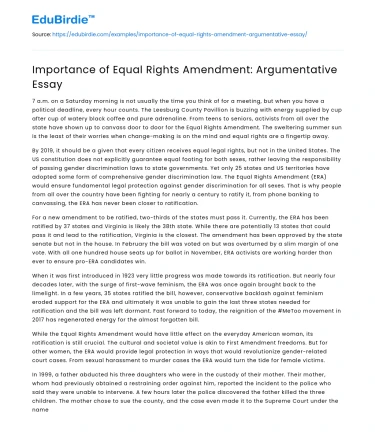7 a.m. on a Saturday morning is not usually the time you think of for a meeting, but when you have a political deadline, every hour counts. The Leesburg County Pavillion is buzzing with energy supplied by cup after cup of watery black coffee and pure adrenaline. From teens to seniors, activists from all over the state have shown up to canvass door to door for the Equal Rights Amendment. The sweltering summer sun is the least of their worries when change-making is on the mind and equal rights are a fingertip away.
By 2019, it should be a given that every citizen receives equal legal rights, but not in the United States. The US constitution does not explicitly guarantee equal footing for both sexes, rather leaving the responsibility of passing gender discrimination laws to state governments. Yet only 25 states and US territories have adopted some form of comprehensive gender discrimination law. The Equal Rights Amendment (ERA) would ensure fundamental legal protection against gender discrimination for all sexes. That is why people from all over the country have been fighting for nearly a century to ratify it, from phone banking to canvassing, the ERA has never been closer to ratification.
For a new amendment to be ratified, two-thirds of the states must pass it. Currently, the ERA has been ratified by 37 states and Virginia is likely the 38th state. While there are potentially 13 states that could pass it and lead to the ratification, Virginia is the closest. The amendment has been approved by the state senate but not in the house. In February the bill was voted on but was overturned by a slim margin of one vote. With all one hundred house seats up for ballot in November, ERA activists are working harder than ever to ensure pro-ERA candidates win.
When it was first introduced in 1923 very little progress was made towards its ratification. But nearly four decades later, with the surge of first-wave feminism, the ERA was once again brought back to the limelight. In a few years, 35 states ratified the bill, however, conservative backlash against feminism eroded support for the ERA and ultimately it was unable to gain the last three states needed for ratification and the bill was left dormant. Fast forward to today, the reignition of the #MeToo movement in 2017 has regenerated energy for the almost forgotten bill.
While the Equal Rights Amendment would have little effect on the everyday American woman, its ratification is still crucial. The cultural and societal value is akin to First Amendment freedoms. But for other women, the ERA would provide legal protection in ways that would revolutionize gender-related court cases. From sexual harassment to murder cases the ERA would turn the tide for female victims.
In 1999, a father abducted his three daughters who were in the custody of their mother. Their mother, whom had previously obtained a restraining order against him, reported the incident to the police who said they were unable to intervene. A few hours later the police discovered the father killed the three children. The mother chose to sue the county, and the case even made it to the Supreme Court under the name Gonzales V.S Town of Castle Rock. However, the court ruled the 14 Amendment, which proclaims every citizen of the US is granted equal civil and legal rights, does not compel county officials to protect women against domestic violence, leading the defendant to win.
With an amendment added into the constitution cases like Gonzales V.S Town of Castle Rock can be tried justly. The amendment would require the government to intervene in cases of domestic abuse as a form of sex discrimination. This legal framework would have tipped the scale in favor of the mother in a case of blatant neglect on the county’s side allowing her to get the justice she deserved. Providing fundamental legal backing is crucial to cases that can be interpreted as gender discrimination. While smaller laws like Title IV, which is to prohibit discrimination on the basis of sex in any education program or activity that is federally funded, have been put in place they only protect very specific cases and many loopholes can be found.
While many see the ERA as only advantageous to women, it also provides legal equity for men. In certain areas of law, like family law and paternity suits, men face gender discrimination. For instance, in cases of child custody nearly 90% of the time the mother gains custody, many times because of internalized stereotypes. This unchecked bias is a form of gender discrimination, but without gender-neutral anti-discriminatory laws, cases go untried. With the ERA men will be able to call upon the court system and possess a solid legal framework for their case. The amendment will finally grant men legal equality in areas that have historically favored women.
Many skeptics see the Equal Rights Amendment as an unsettling attempt to introduce abortion rights into the Consitution, however, that is not the main focus of the ERA, in fact, reproductive rights are not mentioned at all in the mere 52 words of the amendment. Others claim the ERA is no longer necessary considering policies and laws placed by federal and state governments. But laws can change depending on the current administration, which has already happened with the Violence Against Women Act which was left to expire without the introduction of an alternative. Having the ERA in the Constitution would keep equal rights safe from destructive anti-feminist administrations and make it a permanent part of our society.






 Stuck on your essay?
Stuck on your essay?

